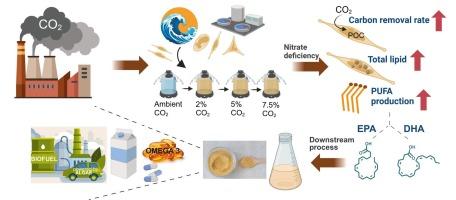逐步二氧化碳驯化后三角褐指藻的碳捕获和多不饱和脂肪酸生产增强
IF 4.5
2区 生物学
Q1 BIOTECHNOLOGY & APPLIED MICROBIOLOGY
Algal Research-Biomass Biofuels and Bioproducts
Pub Date : 2025-09-08
DOI:10.1016/j.algal.2025.104298
引用次数: 0
摘要
工业烟气是二氧化碳排放的主要来源。目前,探索如何利用微藻对其进行吸收,产生更多的脂类和多不饱和脂肪酸(PUFAs)已成为一个有前景的研究方向。然而,在高CO2浓度下保持微藻的生长速度仍然是研究的关键瓶颈。为此,我们首创了一种循序渐进的二氧化碳驯化方法,即从南中国海分离出来的一种生长迅速、多聚脂肪酸含量高的模型硅藻——三角褐藻(Phaeodactylum tricornutum),依次驯化为2%、5%和7.5%的二氧化碳。结果表明,这种方法能够实现更稳定的增长。驯化后细胞直径增大,碳积累量增大,碳捕获率和脂质产量增大。与0.04% CO2 +高氮处理(ACHN)相比,7.5% CO2 +高氮处理(HCLN)在6 h时碳捕获率提高了69.1%,在6 h、12 h和24 h时脂质产量分别提高了32%、46%和44%。此外,还促进了PUFAs的产生,特别是二十碳五烯酸(EPA)和二十二碳六烯酸(DHA)。HCLN对EPA和DHA的促进作用在6 h达到最大,分别比ACHN增加64%和280%。本研究表明,逐步CO2驯化策略是微藻捕获CO2并产生脂质和pufa的有效途径,有利于烟气处理和产品市场(如生物燃料和医疗保健)的结合。本文章由计算机程序翻译,如有差异,请以英文原文为准。

Enhanced carbon capture and polyunsaturated fatty acid production by Phaeodactylum tricornutum after stepwise CO2 acclimation
Industrial flue gas serves as a major source of CO2 emissions. Currently, the exploration on how to use microalgae to absorb it and produce more lipids and polyunsaturated fatty acids (PUFAs) has emerged as a promising research direction. However, maintaining microalgal growth rates under high CO2 concentrations remains a key bottleneck in research. In response to this, we pioneered a stepwise CO2 acclimation approach, whereby Phaeodactylum tricornutum—a model diatom isolated from the South China Sea with rapid growth and high PUFA content—were sequentially acclimated to 2 %, 5 % and 7.5 % CO2. The results demonstrated that this approach enabled more stable growth. Furthermore, after acclimation, larger cell diameter, more carbon accumulation, higher carbon capture rate and lipid production were attained. The coupling of 7.5 % CO2 and nitrogen deficiency (HCLN) resulted in 69.1 % higher carbon capture rate at 6 h and induced higher lipid productivity by 32 %, 46 % and 44 % at 6 h, 12 h and 24 h, respectively compared to 0.04 % CO2 & high nitrogen (ACHN). In addition, the production of PUFAs was also promoted, especially for eicosapentaenoic acid (EPA) and docosahexaenoic acid (DHA). The maximum promoting effect of HCLN on EPA and DHA appeared at 6 h with increases of 64 % and 280 % respectively compared to ACHN. This study suggests that the stepwise CO2 acclimation strategy is an effective approach for microalgae to capture CO2 and produce lipid and PUFAs, which is beneficial for the combination of flue gas treatment and product markets (e.g., biofuel and health care).
求助全文
通过发布文献求助,成功后即可免费获取论文全文。
去求助
来源期刊

Algal Research-Biomass Biofuels and Bioproducts
BIOTECHNOLOGY & APPLIED MICROBIOLOGY-
CiteScore
9.40
自引率
7.80%
发文量
332
期刊介绍:
Algal Research is an international phycology journal covering all areas of emerging technologies in algae biology, biomass production, cultivation, harvesting, extraction, bioproducts, biorefinery, engineering, and econometrics. Algae is defined to include cyanobacteria, microalgae, and protists and symbionts of interest in biotechnology. The journal publishes original research and reviews for the following scope: algal biology, including but not exclusive to: phylogeny, biodiversity, molecular traits, metabolic regulation, and genetic engineering, algal cultivation, e.g. phototrophic systems, heterotrophic systems, and mixotrophic systems, algal harvesting and extraction systems, biotechnology to convert algal biomass and components into biofuels and bioproducts, e.g., nutraceuticals, pharmaceuticals, animal feed, plastics, etc. algal products and their economic assessment
 求助内容:
求助内容: 应助结果提醒方式:
应助结果提醒方式:


